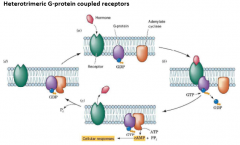![]()
![]()
![]()
Use LEFT and RIGHT arrow keys to navigate between flashcards;
Use UP and DOWN arrow keys to flip the card;
H to show hint;
A reads text to speech;
10 Cards in this Set
- Front
- Back
- 3rd side (hint)
|
Describe the following types of signaling:
1) Endocrine 2) Paracrine 3) Autocrine |
1) Signal affects distant targets
2) Signal affects close targets (usually neighboring cells) 3) Cell sends a signal that affects itself |
|
|
|
Name 2 types of receptors.
|
1) Steroid hormone receptor
2) Heterotrimeric G-protein coupled receptor |
|
|
|
How does cortisol induce transcription? (5 steps)
|
1) Cortisol is a steroid so it is hydrophobic. This means it can diffuse through the cell membrane into the cytoplasm.
2) Cortisol binds to a cytoplasmic steroid receptor 3) Binding causes the signal to move inside the nucleus and bind to half of a palindromic DNA sequence. 4) Another receptor comes in to bind the other half. 5) Transcription of a large number of genes is activated. |
|
|
|
How does retinoic acid induce transcription? (1 step)
|
1) Retinoic acid is also a steroid. It can diffuse all the way into the nucleus, where its receptor is.
|
|
|
|
Name 3 second messengers.
|
1) IP3 (Inositol triphosphate)
2) Ca++ (calcium) 3) cAMP (cyclic AMP) |
|
|
|
What are the 6 steps in target activation by heterotrimeric G-Proteins?
|
1) Hormone binds receptor.
2) G-protein (with GDP bound) binds to the receptor. 3) G-protein exchanges GDP for GTP, becoming active. 4) G-protein dissociates from the receptor and binds to adenylate cyclase. 5) Adenylate cyclase converts ATP to cAMP (second messenger) 6) G-protein's GTP loses a phosphate to become GDP, which makes the receptor inactive and starts the cycle over. |

|
|
|
How does epinephrine cause activation of glycogen phosphorylase? (4 steps)
|
1) Epinephrine binds to α-adenergic receptor
2) This activates the G protein by allowing it to exchange GDP for GTP. 3) G-protein dissociates from the receptor and binds to phospholipase C (PLC). 4) PLC cleaves PIP to create IP3 (inositol triphosphate) and DG. 5) IP3 binds to a ligand-gated calcium ion channel on the endoplasmic reticulum. 6) The channel makes a conformational change which allows calcium to flow into the cell. The calcium binds calmodulin. 7) Calmodulin activates glycogen phosphorylase kinase which phosphorylates Glycogen Phosphorylase. |
|
|
|
How do receptor tyrosine kinases work?
|
1) A hormone binds to the receptor's extracellular domain (outside the cell); this causes the receptors to dimerize.
2) The intracellular domain phosphorylates tyrosines using the γ-phosphate of ATP. 3) The phosphorylated tyrosines then become signals that other factors bind to, which causes amplification of the signal. |
|
|
|
Explain how protein growth factors work via the Ras pathway to increase the transcription of target genes. (6 steps)
|
*hint* the first 3 steps are the receptor tyrosine kinase steps.
1) Protein growth factor binds to outside of the receptor. 2) Receptor dimerizes 3) Tyrosine protein kinase domains on the receptors phosphorylate each other. 4) SH2 domain of Ras (with GDP bound) binds to phosphorylated tyrosine. 5) Ras exchanges GDP for GTP, becoming active. 6) Ras can now phosphorylate several other effectors (which can effect multiple things) |
|
|
|
When blood concentrations of glucose drop and the pancreas secretes glucagon, the glucagon binds to a G-protein coupled receptor on liver cells. What are the 3 steps between glucagon binding the receptor and phosphorylase kinase activation?
|
1) Glucagon binds to the G-protein coupled receptor.
2) The receptor undergoes a conformational change, permitting the G-protein to exchange GDP for GTP (activating the G-protein) 3) The GTP-bound G-protein dissociates... 4) ... and binds adenylcyclase, activating it and releasing cAMP (cyclic AMP), which binds to PKA and activates it. 5) PKA phosphorylates Phosphorylase Kinase. |
|

